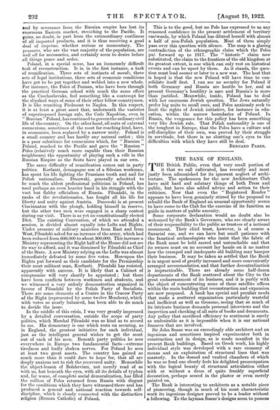THE BANK OF ENGLAND. T HE British Public, even that very
small portion of it that we call cultivated, has recently and most justly been admonished for its ignorant neglect of archi- tecture. The spokesmen for the new Architecture Club have said hard and salutary things of both Press and public, but have also added advice and action to their criticism. Now that even the " Registered Reader " appears to have been genuinely stirred by the proposal to rebuild the Bank of England an unusual opportunity seems to have come to the Club for the exercise of its function as guide in matters of public amenity. Some corporate declaration would no doubt also be welcomed by the Bank's Governors, who are clearly aware of their responsibility to the public as trustees of a national monument. Their chief trust, however, is of course a financial one, and we can have but small patience with the fanatical archaeologists who insist that the fabric of the Bank must be held sacred and untouchable and that its owners must on no account lay hands on it no matter how the cramped and inadequate old building may hamper their business. It may be taken as settled that the Bank is in urgent need of greatly increased and more conveniently arranged accommodation and that further decentralization is impracticable. There are already some half-dozen departments of the Bank scattered about the City to the great embarrassment of its business, and it is partly with the object of concentrating some of these satellite offices within the main building that reconstruction and expansion are now proposed. A bank has special and peculiar needs that make a scattered organization particularly wasteful and inefficient as well as tiresome, seeing that so much of its intricate business demands personal interviews and the inspection and checking of all sorts of books and documents. Any policy that sacrificed efficiency to sentiment is surely as undesirable as it is impossible when it is our national finances that are involved.
Sir John Soane was an exceedingly able architect and an ingenious and sometimes inspired experimenter both in construction and in design, as is made manifest in the present Bank buildings. Based on Greek work, his highly individual style was developed with a rare economy of means and an exploitation of structural lines that was masterly. In the domed and vaulted chambers of which he was so fond one clearly feels his delighted preoccupation with the logical beauty of structural articulation either with or without a dress of quite frankly superficial decoration, perhaps scored in the plaster or even merely painted on. The Bank is interesting to architects as a notable piece of pioneering, though in much of his most characteristic work its ingenious designer proved to be a leader without a following. To the layman Soane's designs seem to possess a certain meagre " sadness " and, being largely carried out in plaster, his London interiors are admittedly not very festive-looking in their usually dingy condition. Certainly no work by so interesting an architect should be lightly destroyed, and the Bank authorities have in- structed their architects, Mr. Baker and Mr. Troup, to preserve whatever of the present remarkable and historic labyrinth may be found compatible with a radical rebuild- ing. That surely is as far as it is reasonable for the Governors to go, and those who protest that the instructions should limit the architects to doing the best that they can without disturbing Soane's work would seem to have lost all sense of proportion. We have recently been assured that we now have amongst us architects fit to be compared with those of any age in our past history and that it is only opportunities that they lack. If that be so (and. we are disposed to believe it), why should we assume that any operation on the Bank— the heart of the City—must prove architecturally fatal and not beneficial ? Both Mr. Baker and Mr. Troup have given us proof of their high ability elsewhere, and they have put forward an ingenious yet reasonable plan for the Bank's enlargement by building a tall keep within the old low ramparts. It is necessarily tentative, and the elevations obviously need more thought, but on the whole we should be inclined to mark the projet " Approved—, submit scheme in more detail, with revisions."
In conclusion, we should like to express our appreciation of the Bank's enlightened courtesy in putting its proposals to the public vote by furnishing the tress with such business- like plans and notes as have come to us. We get the archi- tecture that we deserve, and if public opinion in such matters can only be sufficiently educated, we shall soon have buildings of a more civilized sort by firmly black- balling and ostracizing the barbarous.



































 Previous page
Previous page